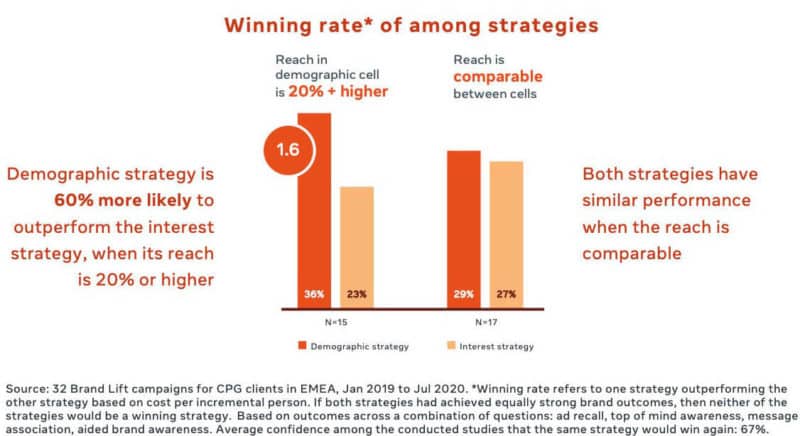Demographic audiences double the reach of narrow interest audiences, Facebook says
However, both strategies perform similarly when reach is comparable.
The analysis included 50 CPG campaigns in the EMEA region, measured using Facebook Brand Lift.
Why we care. The big takeaway from Facebook’s analysis is that some interest audiences are too small to generate scale when compared with demographic audiences. Advertisers should assess their interest audiences and decide whether the higher impact is worth potentially diminished reached and higher CPM.
If interest audiences are broad enough, they can perform comparably with demographic audiences. In that case, advertisers should select the strategy that best matches their campaign goals.
While these findings make sense, they’re also convenient for Facebook, since Apple’s App Tracking Transparency doesn’t affect demographic targeting.
Demographic outperforms interest audiences that are too narrow. Interest-based targeting is inherently more limited than demographic-based targeting. To overcome that difference, the campaign with the lower reach needs to compensate with greater efficiency. Interest targeting does deliver greater efficiency, but it’s unlikely to make up the difference.

“Among the campaigns with significantly reduced reach due to interest targeting, the effectiveness was slightly higher compared to the demographic audiences (+22%),” Facebook said, “However, this increase was slightly below the required threshold and was unlikely to sufficiently compensate for the lower reach. As a result, demographic strategy was 1.6 times more likely to be the winning strategy and drove more cost-efficient brand outcomes compared to the interest strategy in these campaigns.” When interest audiences were too narrow, demographic audiences also delivered 99% more reach than interest audiences on the same budget.
Both demographic- and interest-based targeting can deliver reach. The two strategies achieved comparable reach with the same budget when interest audiences were broad enough to provide sufficient reach. When both could deliver comparable reach — within 20% of the other — for the same budget, Facebook’s analysis showed that they were equally likely to be the winning, cost-effective strategy.

“This finding implies that some broader interest audiences can generate scale of reach comparable to demographic audiences and marketers can select either of the strategies while maximizing the alignment to the category buyers,” Facebook said.
Your objectives should dictate your strategy. Demographic targeting was the winning strategy 1.6x more often at the top of the funnel, while interest targeting was the winning strategy 2x more often at the bottom of the funnel, according to the analysis.

This means that interest audiences may be better for lower-funnel objectives, like driving purchase intent and consideration, while demographic audiences might be more likely to drive upper-funnel objectives, such as brand awareness. Advertisers should select the strategy that best matches their campaign’s specific goals. Using both strategies appropriately can enable brands to drive both upper and lower funnel outcomes.




